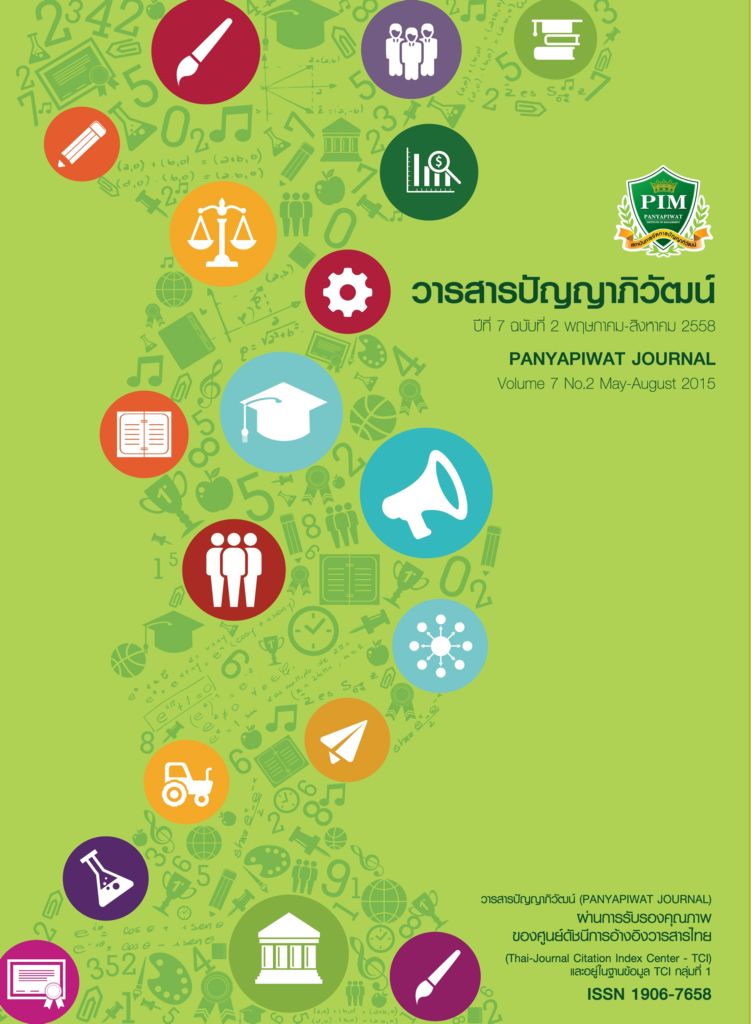ความสัมพันธ์ระหว่างคุณค่าตราสินค้า ส่วนประสมทางการตลาด และความพึงพอใจของผู้ใช้บริการบัตรเครดิตของธนาคารพาณิชย์ไทยที่มีอิทธิพลต่อกลยุทธ์การสร้างความภักดีต่อตราสินค้า
Main Article Content
บทคัดย่อ
บทคัดย่อ
การศึกษาเรื่องความสัมพันธ์ระหว่างคุณค่าตราสินค้า ส่วนประสมทางการตลาด และความพึงพอใจของ
ผู้ใช้บริการบัตรเครดิตของธนาคารพาณิชย์ไทยที่มีอิทธิพลต่อกลยุทธ์การสร้างความภักดีต่อตราสินค้า โดยการใช้แบบสอบถามจากกลุ่มตัวอย่าง คือ ผู้ใช้บริการบัตรเครดิตของธนาคารพาณิชย์ไทย จำนวน 400 ชุด โดยใช้วิธีการสุ่มตัวอย่างแบบเจาะจง ทดสอบความน่าเชื่อถือของเครื่องมือ ตามแนวคิดของครอนบัค (Cronbach Alpha Formula) จำนวน 30 ชุด ได้ผลการทดสอบที่มีความน่าเชื่อถือในระดับสูงมีค่าการทดสอบที่ 0.925 วิเคราะห์ผลโดยใช้สถิติเชิงพรรณนา ได้แก่ การแจงความถี่ ร้อยละ ค่าเฉลี่ย ค่าเบี่ยงเบนมาตรฐานและวิเคราะห์ข้อมูลเชิงปริมาณ ทดสอบความแตกต่างโดยใช้สถิติแบบ t-test, F-test, ทดสอบค่าเฉลี่ยความแตกต่างรายคู่โดยวิธี LSD (Least Significant Difference) และทดสอบความสัมพันธ์โดยใช้สถิติทดสอบแบบ Pearson’s Correlation Coefficient ระดับนัยสำคัญทางสถิติที่ 0.05 ประมวลผลข้อมูลจากโปรแกรมคอมพิวเตอร์สำเร็จรูปทางสถิติ นำเสนอผลการวิเคราะห์ข้อมูลและการแปลผลในรูปแบบตารางประกอบคำอธิบายจากการทดสอบความสัมพันธ์ พบว่า ปัจจัยด้านคุณค่าตราสินค้ามีความสัมพันธ์เชิงบวกกับกลยุทธ์การสร้างความภักดีต่อตราสินค้าของผู้ใช้บริการบัตรเครดิตของธนาคารพาณิชย์ไทย โดยปัจจัยด้านคุณค่าตราสินค้า ด้านการรับรู้ตราสินค้า (ค่าเฉลี่ย = 3.92) มีความสัมพันธ์สูงที่สุด รองลงมา ด้านการเชื่อมโยงตราสินค้า (ค่าเฉลี่ย = 3.81) และ
ด้านการรับรู้คุณภาพ (ค่าเฉลี่ย = 3.76) ตามลำดับ ปัจจัยส่วนประสมทางการตลาด มีความสัมพันธ์เชิงบวกกับกลยุทธ์การสร้างความภักดีต่อตราสินค้าของผู้ใช้บริการบัตรเครดิตของธนาคารพาณิชย์ไทย โดยปัจจัยส่วนประสมทางการตลาด ด้านช่องทางการจัดจำหน่าย (ค่าเฉลี่ย = 3.82) มีความสัมพันธ์สูงที่สุด รองลงมา ด้านการส่งเสริมการตลาด (ค่าเฉลี่ย = 3.76) ด้านผลิตภัณฑ์ (ค่าเฉลี่ย = 3.75) และด้านราคา (ค่าเฉลี่ย = 3.48) ตามลำดับ และปัจจัยด้านความพึงพอใจต่อการใช้บริการ มีความสัมพันธ์เชิงบวกกับกลยุทธ์การสร้างความภักดีต่อตราสินค้าของผู้ใช้บริการบัตรเครดิตของธนาคารพาณิชย์ไทย โดยปัจจัยด้านความพึงพอใจต่อการใช้บริการ ด้านลักษณะทางกายภาพของการบริการ(ค่าเฉลี่ย = 3.76) มีความสัมพันธ์สูงที่สุด รองลงมา ด้านกระบวนการให้บริการ (ค่าเฉลี่ย = 3.73) และด้านพนักงาน
ผู้ให้บริการ (ค่าเฉลี่ย = 3.72) ตามลำดับ
Abstract
These research studies the relationship between brand equity, marketing mix and customer satisfaction of Thai commercial bank’s credit card for their influences on strategies to build brand loyalties. The sample is a credit card in Thailand to 400 samples using judgemental sampling.
Reliability testing of According to the Cronbach (Cronbach Alpha Formula) were 30 sets of test results are reliable, high levels were tested at 0.925 analyzed using descriptive statistics such as parsing, frequency, percentage, mean, standard deviation, and analyzed quantitatively. To test the difference by statistical model t–test, F-test, test mean difference pairs using LSD (Least Significant Difference) and correlations using statistical tests. Pearson’s Correlation Coefficient is significant level of 0.05 processing of statistical data on the computer. Present the results of data analysis and interpretation in a table format explanatory.
The correlation test showed that the brand equity has a positive relationship with strategies to build brand loyalties to the brand of customer satisfaction of Thai commercial bank’s credit card by the factors of brand equity, the brand awareness (Mean = 3.92), the relationship is highest, followed by the brand association (Mean = 3.81) and the perceived quality (Mean = 3.76), respectively.
The marketing mix has a positive relationship with strategies to build brand loyalties to the brand of customer satisfaction of Thai commercial bank’s credit card by the factors of the marketing mix, the place (Mean = 3.82), the relationship is highest, followed by the promotion (Mean = 3.76), the product (Mean = 3.75) and the price (Mean = 3.48), respectively. The satisfaction of the service has a positive relationship with strategies to build brand loyalties to the brand of customer satisfaction of Thai commercial bank’s credit card, by the factors of the marketing mix, the physical evidence (Mean = 3.76), the relationship is highest, followed by the service process (Mean = 3.73) and the staff or people (Mean = 3.72), respectively.
Article Details
“ข้าพเจ้าและผู้เขียนร่วม (ถ้ามี) ขอรับรองว่า บทความที่เสนอมานี้ยังไม่เคยได้รับการตีพิมพ์และไม่ได้อยู่ระหว่างกระบวนการพิจารณาลงตีพิมพ์ในวารสารหรือแหล่งเผยแพร่อื่นใด ข้าพเจ้าและผู้เขียนร่วมยอมรับหลักเกณฑ์การพิจารณาต้นฉบับ ทั้งยินยอมให้กองบรรณาธิการมีสิทธิ์พิจารณาและตรวจแก้ต้นฉบับได้ตามที่เห็นสมควร พร้อมนี้ขอมอบลิขสิทธิ์บทความที่ได้รับการตีพิมพ์ให้แก่สถาบันการจัดการปัญญาภิวัฒน์หากมีการฟ้องร้องเรื่องการละเมิดลิขสิทธิ์เกี่ยวกับภาพ กราฟ ข้อความส่วนใดส่วนหนึ่งและ/หรือข้อคิดเห็นที่ปรากฏในบทความข้าพเจ้าและผู้เขียนร่วมยินยอมรับผิดชอบแต่เพียงฝ่ายเดียว”
References
จิตตินันท์ เดชะคุปต์. (2539). เจตคติและความพึงพอใจในการบริการ. เอกสารการสอนชุดจิตวิทยาการบริการหน่วยที่ 8-15. (พิมพ์ครั้งที่ 2). นนทบุรี: มหาวิทยาลัยสุโขทัยธรรมธิราช.
ธนาคารแห่งประเทศไทย. (2557).สถิติระบบการชำระเงิน. สืบค้นเมื่อ 15 กรกฎาคม 2557, จาก http://www.bot.or.th
มีนา อ่องบางน้อย. (2553). คุณค่าตราสินค้า ความไว้วางใจ และความพึงพอใจที่มีผลต่อความภักดีต่อตราสินค้า CAT CDMA (แคท ซีดีเอ็มเอ). วารสารปัญญาภิวัฒน์, 2(1), 52-69.
ศรีกัญญา มงคลศิริ. (2547). Brand Management. กรุงเทพฯ: แบรนด์เอจ.
ศิริวรรณ เสรีรัตน์. (2539). องค์การและการจัดการ. กรุงเทพฯ: สำนักพิมพ์พัฒนาศึกษา.
ศิริวรรณ เสรีรัตน์ และคณะ. (2541). การบริหารการตลาดยุคใหม่. กรุงเทพฯ: Diamond in business world.
ศุภชาติ เกตุแค. (2552).ความสัมพันธ์ระหว่างความพึงพอใจและความภักดีต่อตราสินค้าโทรศัพท์มือถือ. สาขาวิชาบริหารธุรกิจ บัณฑิตวิทยาลัย, มหาวิทยาลัยเชียงใหม่.
เสรี วงษ์มณฑา. (2542). กลยุทธ์การตลาด: การวางแผนการตลาด. กรุงเทพฯ: บริษัท ธีระฟิล์ม และไซเท็กซ์ จำกัด.
สุพรรณิการ์ มรรคาสกุล. (2555). ปัจจัยที่มีผลต่อการเกิดความจงรักภักดีในการใช้บัตรเครดิต กรณีศึกษา ผู้ใช้บัตรเครดิตในเขตกรุงเทพมหานคร. เศรษฐศาสตร์มหาบัณฑิต, มหาวิทยาลัยธรรมศาสตร์.
อาระตี ตันมหาพราน และยุบล เบ็ญจรงค์กิจ. (2552). การวัดคุณค่าตราสินค้าในกลุ่มธุรกิจธนาคารพาณิชย์. วารสารการประชาสัมพันธ์และการโฆษณา, 2(2), 109-126.
อัมพล ชูสนุก. (2555). อิทธิพลของส่วนประสมทางการตลาดบริการต่อคุณค่าตราสินค้า ความพึงพอใจและความจงรักภักดีของลูกค้าบริษัท ทรูมูฟ จำกัด ในเขตกรุงเทพมหานคร. RMUTT Global Business and Economics Review, 7(2), 10-27.
อัมพล ชูสนุก และอังศุมาลิน เฮงมีชัย. (2556). อิทธิพลของคุณภาพการบริการต่อภาพลักษณ์ตราสินค้า คุณค่าตราสินค้าความพึงพอใจ และความจงรักภักดีของลูกค้าที่ใช้บริการโรงเรียนสอนศิลปะดินสอสี.วารสารปัญญาภิวัฒน์, 4(2), 10-23.
โฟกัสหุ้นเด่นรายสัปดาห์. (2557). KTC กำไรปี 56 ทะลัก! 1.28 พันล้านบาทจากธุรกิจสินเชื่อ-บัตรเครดิต ขยายตัวโดดเด่น. สืบค้นเมื่อ 1 กรกฎาคม 2557, จาก http://www.kaohoon.com/online/82041/KTC
Aaker, D. A. (1996). Building Strong Brands. London: Simon & Schuster.
Bain & Company. (2013). Customer Loyalty in Retail Banking : Global Edition 2014. Boston, Massachusetts.
Cobb-Walgren, C. J., Ruble, C. A. & Donthu, N. (1995). Brand Equity, Brand Preference, and Purchase Intent. Journal of Advertising, 24(3),25-40.
Cronbach, L. J. (1990). Essentials of Psychology Testing. New York: Hanpercollins College.
Onyancha, G. K. (2013). The Impact of Bank Brand Image on Customer Satisfaction and Loyalty: A Case of Kenya Commercial Bank. European Journal of Business and Management,5(21), 35-39.
Kotler, P. (2000).Marketing Management,Millennium Edition. Upper Saddle River, New Jersey: Prentice-Hall.
Yamane, T. (1973). Statistics; An Introductory Analysis. (3rd ed.). New York: Harper & Row.
Translated Thai References
Aongbangnoi, M. (2010). Brand value the trust and satisfaction that affect brand loyalty CAT CDMA. Panyapiwat Journal, 2(1), 52-69. [in Thai]
Bank of Thailand. (2014). Statisticalpayment system. Retrieved July 15, 2557, from http://www.bot.or.th [in Thai]
Choosanook, A. (2012). The influence of the marketing mix for a brand value. Customer satisfaction and customer loyalty True Move Company Limited in Bangkok. RMUTT Global Business and Economics Review, 7(2), 10-27. [in Thai]
Choosanook, A. & Hengmechai, A. (2013). The influence of the quality of service brand image: Brand equity, customer satisfaction and loyalty of customers using pencil art schools. Panyapiwat Journal, 4(2), 10-23. [in Thai]
Dachakhup, J. (1996). Attitudesand satisfactionin service.Inpsychologicalservicesunit 8-15. (2nded.). Nonthaburi: Sukhothai Thammathirat University. [in Thai]
Kaohoon. (2014). KTCearnings of56blowout! 1.28 billionbahtfromcredit- credit cards. Retrieved July 1, 2557, from http://www.kaohoon.com/online/82041/KTC [ i n T h a i ]
Kedcare, S. (2009). The relationship between satisfaction and loyalty to your brand mobile phone. Business Administration. Graduate School, Chiang Mai University. [in Thai]
Mongkolsiri, S. (2004). Brand Management. Bangkok: Band Age. [in Thai]
Munkasakul, S. (2012). Factorsthat affectthe fidelityofcredit cardcasecredit card usersin Bangkok. Faculty of Ecomomics, Thammasat University. [in Thai]
Searirat, S. (1996). Organization and management. Bangkok: The publisher of education. [in Thai]
Searirat, S. et al. (1998).Marketing management:a new era. Bangkok. Diamond in business world. [in Thai]
Tunmahaparn, A. & Penjarongkit, Y. (2009). Measuring brand value in the banking business. Journal of Public Relations and Advertising, 2(2), 109-126. [in Thai]
Wongmoltha, S. (1999). Marketing Strategies:Marketing Planning. Bangkok: Theera film and Scitex Co., Ltd. [in Thai]

